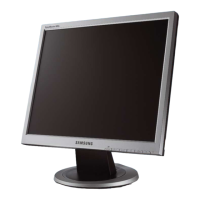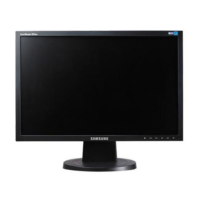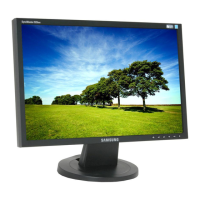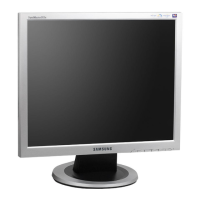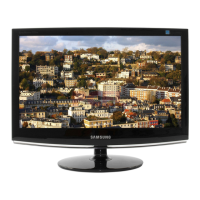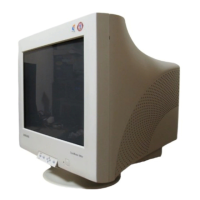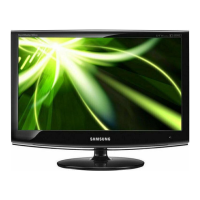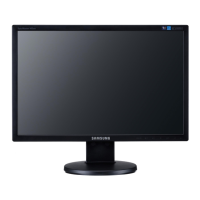Do you have a question about the Samsung SyncMaster 920BW and is the answer not in the manual?
Safety symbols and warnings for user protection.
Monitor power saving modes like DPMS and screen saver usage.
Guidelines for safe usage of the power cord to prevent shock or fire.
Recommendations for monitor placement environment to prevent damage.
Instructions for safely moving and positioning the monitor to avoid injury or damage.
Ensuring proper airflow and secure mounting to prevent overheating or falls.
How to safely clean the monitor case and screen using appropriate materials.
Procedures for cleaning monitor connectors and power cords safely.
Warnings against removing covers and advice on seeking qualified service.
Avoiding hazardous environments and situations like water exposure or chemical contact.
Tips to prevent electrical shock, damage, and eye strain from monitor usage.
Measures to ensure child safety and prevent hazards from unattended monitors.
Guidance on maintaining good posture and reducing eye strain during monitor use.
Explanation of the RTA feature for improving display response speed and image quality.
List of items included with the monitor and identification of different types.
Visual guide to monitor components, manuals, and required cables for setup.
Explanation of the purpose and operation of each physical button on the monitor.
Guide to using MagicBright modes for optimal viewing based on content type.
Details on using the AUTO button for adjustment and the power button for on/off.
Identification of rear ports and the two stand types (Simple and Sliding).
Step-by-step guide for connecting the monitor to PC using D-sub or DVI cables.
How to connect digital devices like DVD players using DVI or HDMI cables.
Information on attaching the monitor base and VESA mounting compatibility.
Steps for automatically installing monitor drivers using the included CD-ROM.
Detailed steps for installing drivers on Windows XP/2000, including handling warnings.
Advanced procedures for installing drivers via Device Manager in Windows.
Guide on how to manually select and install driver files from a disk or CD.
Specific instructions for manual driver installation on Windows 2000, Millennium, and NT operating systems.
Steps for configuring monitor settings on a Linux operating system using X-Window.
Overview of the Natural Color Pro software for color management and image quality improvement.
How to install and uninstall the Natural Color software program.
Explanation of the purpose and operation of each physical button on the monitor.
Details on how the AUTO button automatically adjusts the monitor's picture.
How to lock OSD settings and cycle through MagicBright modes.
Adjusting monitor brightness and selecting the video input source.
Adjusting brightness and contrast settings via the On-Screen Display (OSD) menu.
Utilizing MagicColor for natural colors and MagicZone for enhanced multimedia display.
Fine-tuning image quality by adjusting noise, position, and clarity using the Image tab.
Customizing OSD language and its on-screen position for user convenience.
Configuring automatic source selection, image reset, and color reset options.
Details on Response Time Accelerator and how to display system information on screen.
Introduction to MagicTune software for optimizing monitor performance and picture quality.
Steps for starting the MagicTune software installation process from the CD-ROM.
Accepting the license agreement and choosing an installation folder for MagicTune.
Finalizing the installation process and locating the MagicTune executable icon.
Common issues encountered during MagicTune installation and potential solutions.
Essential operating system and hardware specifications required for MagicTune compatibility.
How to access and use the OSD mode within MagicTune for monitor adjustments.
Understanding the function of OK, Reset, Cancel buttons and Picture tab settings like Brightness.
Adjusting color tone, balance (RGB) within MagicTune.
Fine-tuning image quality by adjusting noise, position, and clarity using the Image tab.
Configuring MagicTune preferences, source selection, and accessing help resources.
A step-by-step guide to calibrating monitor colors for optimal display results.
How to view the results of color calibration by comparing adjusted vs. original images.
Instructions for safely removing the MagicTune software using Windows Control Panel.
Resolving issues related to system compatibility, video card drivers, and monitor manufacturer.
Guidance on system restarts and troubleshooting video card driver installation for MagicTune.
Addressing conflicts with other programs and finding support on the MagicTune website.
Diagnosing basic display problems related to power, signal cables, and optimal modes.
Resolving issues with display output, color accuracy, OSD lock, and focus.
Addressing problems with monitor drivers, MagicTune functionality, and screen frequency settings.
Information on adjusting screen frequency and where to get further support.
Answers to common questions about resolution, power saving, and performing a monitor self-test.
Understanding warning messages and judging the monitor's working condition.
Tips for optimizing the monitor's environment and performance by managing surrounding devices.
Detailed specifications including model name, panel type, synchronization, and resolution capabilities.
Physical dimensions, power consumption, compliance standards, and pixel dot acceptability.
How the PowerSaver system conserves energy by switching to low-power modes.
Details on power indicator lights and power consumption in different states.
Table listing supported display modes with their horizontal, vertical, and pixel clock frequencies.
Definitions of Horizontal Frequency and Vertical Frequency (Refresh Rate).
Contact phone numbers and websites for Samsung support in North and Latin America.
Contact phone numbers and websites for Samsung support in Europe, CIS, and Asia Pacific regions.
Definitions of key terms like Dot Pitch, Vertical/Horizontal Frequency, and Resolution.
Tips for adjusting computer resolution and refresh rate for optimal picture quality.
Advice on cleaning the monitor and improving picture quality through adjustments.
Information regarding copyright, trademarks, and company liability.
Explanation of image retention and recommendations for power off and screen saver usage.
Strategies for preventing image retention in specific applications and understanding the LCD mechanism.
Guidelines for the correct disposal and recycling of electronic waste in Europe.
Safety symbols and warnings for user protection.
Monitor power saving modes like DPMS and screen saver usage.
Guidelines for safe usage of the power cord to prevent shock or fire.
Recommendations for monitor placement environment to prevent damage.
Instructions for safely moving and positioning the monitor to avoid injury or damage.
Ensuring proper airflow and secure mounting to prevent overheating or falls.
How to safely clean the monitor case and screen using appropriate materials.
Procedures for cleaning monitor connectors and power cords safely.
Warnings against removing covers and advice on seeking qualified service.
Avoiding hazardous environments and situations like water exposure or chemical contact.
Tips to prevent electrical shock, damage, and eye strain from monitor usage.
Measures to ensure child safety and prevent hazards from unattended monitors.
Guidance on maintaining good posture and reducing eye strain during monitor use.
Explanation of the RTA feature for improving display response speed and image quality.
List of items included with the monitor and identification of different types.
Visual guide to monitor components, manuals, and required cables for setup.
Explanation of the purpose and operation of each physical button on the monitor.
Guide to using MagicBright modes for optimal viewing based on content type.
Details on using the AUTO button for adjustment and the power button for on/off.
Identification of rear ports and the two stand types (Simple and Sliding).
Step-by-step guide for connecting the monitor to PC using D-sub or DVI cables.
How to connect digital devices like DVD players using DVI or HDMI cables.
Information on attaching the monitor base and VESA mounting compatibility.
Steps for automatically installing monitor drivers using the included CD-ROM.
Detailed steps for installing drivers on Windows XP/2000, including handling warnings.
Advanced procedures for installing drivers via Device Manager in Windows.
Guide on how to manually select and install driver files from a disk or CD.
Specific instructions for manual driver installation on Windows 2000, Millennium, and NT operating systems.
Steps for configuring monitor settings on a Linux operating system using X-Window.
Overview of the Natural Color Pro software for color management and image quality improvement.
How to install and uninstall the Natural Color software program.
Explanation of the purpose and operation of each physical button on the monitor.
Details on how the AUTO button automatically adjusts the monitor's picture.
How to lock OSD settings and cycle through MagicBright modes.
Adjusting monitor brightness and selecting the video input source.
Adjusting brightness and contrast settings via the On-Screen Display (OSD) menu.
Utilizing MagicColor for natural colors and MagicZone for enhanced multimedia display.
Fine-tuning image quality by adjusting noise, position, and clarity using the Image tab.
Customizing OSD language and its on-screen position for user convenience.
Configuring automatic source selection, image reset, and color reset options.
Details on Response Time Accelerator and how to display system information on screen.
Introduction to MagicTune software for optimizing monitor performance and picture quality.
Steps for starting the MagicTune software installation process from the CD-ROM.
Accepting the license agreement and choosing an installation folder for MagicTune.
Finalizing the installation process and locating the MagicTune executable icon.
Common issues encountered during MagicTune installation and potential solutions.
Essential operating system and hardware specifications required for MagicTune compatibility.
How to access and use the OSD mode within MagicTune for monitor adjustments.
Understanding the function of OK, Reset, Cancel buttons and Picture tab settings like Brightness.
Adjusting color tone, balance (RGB) within MagicTune.
Fine-tuning image quality by adjusting noise, position, and clarity using the Image tab.
Configuring MagicTune preferences, source selection, and accessing help resources.
A step-by-step guide to calibrating monitor colors for optimal display results.
How to view the results of color calibration by comparing adjusted vs. original images.
Instructions for safely removing the MagicTune software using Windows Control Panel.
Resolving issues related to system compatibility, video card drivers, and monitor manufacturer.
Guidance on system restarts and troubleshooting video card driver installation for MagicTune.
Addressing conflicts with other programs and finding support on the MagicTune website.
Diagnosing basic display problems related to power, signal cables, and optimal modes.
Resolving issues with display output, color accuracy, OSD lock, and focus.
Addressing problems with monitor drivers, MagicTune functionality, and screen frequency settings.
Information on adjusting screen frequency and where to get further support.
Answers to common questions about resolution, power saving, and performing a monitor self-test.
Understanding warning messages and judging the monitor's working condition.
Tips for optimizing the monitor's environment and performance by managing surrounding devices.
Detailed specifications including model name, panel type, synchronization, and resolution capabilities.
Physical dimensions, power consumption, compliance standards, and pixel dot acceptability.
How the PowerSaver system conserves energy by switching to low-power modes.
Details on power indicator lights and power consumption in different states.
Table listing supported display modes with their horizontal, vertical, and pixel clock frequencies.
Definitions of Horizontal Frequency and Vertical Frequency (Refresh Rate).
Contact phone numbers and websites for Samsung support in North and Latin America.
Contact phone numbers and websites for Samsung support in Europe, CIS, and Asia Pacific regions.
Definitions of key terms like Dot Pitch, Vertical/Horizontal Frequency, and Resolution.
Tips for adjusting computer resolution and refresh rate for optimal picture quality.
Advice on cleaning the monitor and improving picture quality through adjustments.
Information regarding copyright, trademarks, and company liability.
Explanation of image retention and recommendations for power off and screen saver usage.
Strategies for preventing image retention in specific applications and understanding the LCD mechanism.
Guidelines for the correct disposal and recycling of electronic waste in Europe.
| Screen Size | 19 inches |
|---|---|
| Resolution | 1440 x 900 |
| Aspect Ratio | 16:10 |
| Panel Type | TN |
| Brightness | 300 cd/m² |
| Contrast Ratio | 1000:1 |
| Response Time | 5 ms |
| Connectivity | VGA, DVI-D |
| Dynamic Contrast Ratio | 3000:1 |
| Viewing Angle (Horizontal) | 160° |
| Viewing Angle (Vertical) | 160° |
| Power Consumption (standby) | 1 W |
